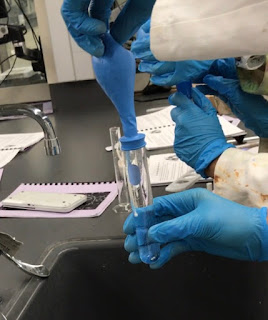Lab 16: Specific Heat of a Metal
Specific Heat of a Metal
Introduction:
The purpose of this lab was the determine the identity of a metal by calculating its specific heat. This could be done by taking the mass and temperature of the different materials. We specifically used water to heat up the metal and used some known information about it to help determine different measurements about the metal like its energy lost and change in temperature. When we completed this lab, we first, heated up the metal in water keeping track of the masses and temperature. Then, we transferred the metal into cooler water to allow the metal to cool and compared the new temperatures to calculate the specific heat.
Data:
These were the measurements for our metal in the experiment:
Calculations:
To find the specific heat of the unknown metal we had to complete a two part calculation which included first finding the energy gained water which was also the energy lost from the metal. This was done by multiplying the mass, specific heat and change of temperature in water. Q=(m)(c)(△T).
This opposite of this number also represents the energy lost from the metal. This then means we could us the opposite or negative of this number to calculate the specific heat by dividing it by the metal's change in temperature and mass. c= Q/[(m)(△T)]
We then took this number and converted it to joules per kilograms times degrees Celsius by simply multiplying by 1000. This could then be compared to our table of specific heats and we matched it to what specific heat was closest. This was brass with a specific heat of 380 J/kg°C.
Sources of Error:
There were several ways this lab could have been messed up mostly because of lack or accuracy with measurements and the close specific heats of metals. First of all, although our scales were very accurate, the thermometers we used only measure by each whole degree which only allowed us to use one decimal place which could change the specific heat slightly. This then leads to the other problem with the fact that some of the specific heats of the metals are very close such as copper and brass. They only had a difference of 6 J/kg°C with brass being 380 J/kg°C and copper being 386 J/kg°C. This means that even the slightest rounding or error in measurement could mean the difference between two completely different metals. These could possibly be errors in our lab especially because our ending specific heat was still a bit off from the actual specific heat.









Comments
Post a Comment